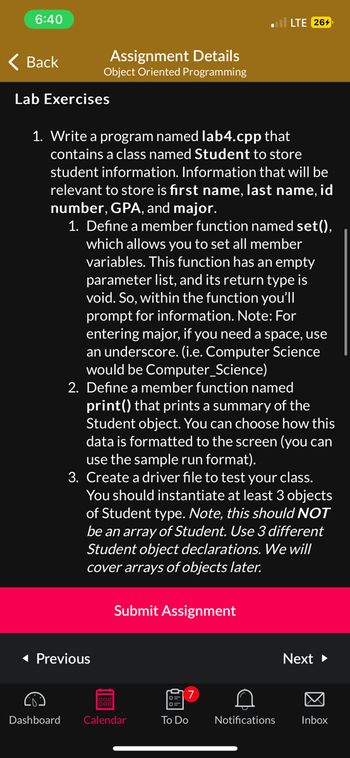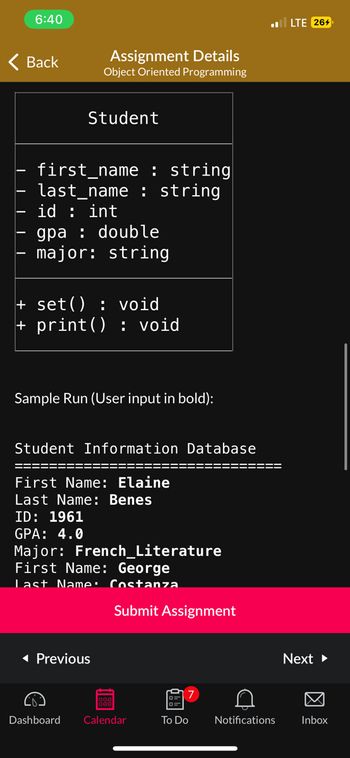
Database System Concepts
7th Edition
ISBN: 9780078022159
Author: Abraham Silberschatz Professor, Henry F. Korth, S. Sudarshan
Publisher: McGraw-Hill Education
expand_more
expand_more
format_list_bulleted
Concept explainers
Question

Transcribed Image Text:6:40
Back
Assignment Details
Object Oriented Programming
Lab Exercises
1. Write a program named lab4.cpp that
contains a class named Student to store
student information. Information that will be
relevant to store is first name, last name, id
number, GPA, and major.
1. Define a member function named set(),
which allows you to set all member
variables. This function has an empty
parameter list, and its return type is
void. So, within the function you'll
prompt for information. Note: For
entering major, if you need a space, use
an underscore. (i.e. Computer Science
would be Computer Science)
◄ Previous
2. Define a member function named
print() that prints a summary of the
Student object. You can choose how this
data is formatted to the screen (you can
use the sample run format).
3. Create a driver file to test your class.
You should instantiate at least 3 objects
of Student type. Note, this should NOT
be an array of Student. Use 3 different
Student object declarations. We will
cover arrays of objects later.
188
Submit Assignment
Dashboard Calendar
7
To Do
LTE 264
C
Notifications
Next ►
Inbox

Transcribed Image Text:6:40
Back
Assignment Details
Object Oriented Programming
Student
first_name : string
last_name: string
id: int
gpa : double
major: string
+ set(): void
+ print(): void
Sample Run (User input in bold):
Student Information Database
First Name: Elaine
Last Name: Benes
ID: 1961
GPA: 4.0
Major: French_Literature
First Name: George
Last Name: Costanza
◄ Previous
Submit Assignment
Dashboard Calendar
7
To Do
C
Notifications
LTE 264
Next ►
Inbox
Expert Solution
This question has been solved!
Explore an expertly crafted, step-by-step solution for a thorough understanding of key concepts.
This is a popular solution
Trending nowThis is a popular solution!
Step by stepSolved in 4 steps

Knowledge Booster
Learn more about
Need a deep-dive on the concept behind this application? Look no further. Learn more about this topic, computer-science and related others by exploring similar questions and additional content below.Similar questions
- Using C++ Write a C++ program which uses a class that contains the following members: the name of a student, one midterm score, one final score, and one lab project score. The class also contains a member function that finds the average of the three scores and displays a grade based on that average (A for 90 and above, B for 80 and above, C for 70 and above, D for 60 and above, and F for anything less than 60). The class also contains a member function that displays a pass if the grade is D or above. Your program using overloading prints the grades of students, and names of the students.arrow_forwardWritten in Python It should have an init method that takes two values and uses them to initialize the data members. It should have a get_age method. Docstrings for modules, functions, classes, and methodsarrow_forwardQuestion 3 Define a function that meets the following specifications Function name Parameters Return value Detailed description Example code Example console output The text in bold are user input. get_equation This function does not take in any values. Return a numeric object, followed by a str type object Using the following prompt, get two numbers. Prompt 1 "Enter first number: " Prompt 2 "Enter second number: " The numeric object to be returned is the numeric sum of the two numbers, the str type object is an addition equation where the two numbers are separated by "+". There is a space between the plus sign and each number. x, y = get_equation () print (x) print (y) Enter first number: 5 Enter second number: 6 11.0 5.0 +6.0arrow_forward
- A Mutator function within a class must have access to the private data item but Accessor functions should not. True False Question 32 4 pts The private and public areas of a class can appear in any order. In other words the public declarations or private declarations can come first...it does not matter. True Falsearrow_forwardTask 2: use c++ to Create an employee class, basing it on Task 1. The member data should comprise an int for storing the employee number and a float for storing the employee’s compensation. Member functions should allow the user to enter this data and display it. Write a main() that allows the user to enter data for three employees and display it.arrow_forwardC++ Write a function named “createPurchaseOrder” that accepts the quantity (integer), the cost per item (double), and the description (string). It will return a newly created PurchaseOrder object holding that information if they are valid: quantity and cost per item cannot be negative and the description cannot be empty or blank(s). When it is invalid, it will return NULL to indicate that it cannot create such PurchaseOrder object.arrow_forward
- Which of the following statements is true about a class' member function definition? a. A function definition provides a class name, return type, arguments, and the functions’ statements. b. A function definition provides the function’s name, return type, and arguments. c. A programmer first defines a function and then declares the member functions. d. A modulus operator is used preceding the function’s name in a function definition.arrow_forwardEach function inside the class A(n)_ is a virtual function. Provide your thoughts by filling in the blanks.arrow_forwardRewrite the calculator program using a class called calculator. Your program will keep asking the user if they want to perform more calculations or quit and will have a function displayMenu to display the different functions e.g .(1 - addition, 2- subtraction, 3- multiplication, 4- division) Your program must have appropriate constructors and member functions to initialize, access, and manipulate the data members as well as : A member function to perform the addition and return the result A member function to perform the subtraction and return the result A member function to perform the multiplication and return the result A member function to perform the division and return the resultarrow_forward
- C++ Write a function named “createPurchaseOrder” that accepts the quantity(integer), the cost per item (double), and the description (string). It will return anewly created PurchaseOrder object holding that information if they are valid:quantity and cost per item cannot be negative and the description cannot be empty or blank(s). When it is invalid, it will return NULL to indicate that it cannot create such PurchaseOrder object. PurchaseOrder createPurchaseOrder(int quantity, double costPerItem, string description) { if(quantity < 0 || costPerItem < 0.0 || description == "") return NULL; else { PurchaseOrder p = new PurchaseOrder(quantity,costPerItem,description); return p; } } what's the issue with this function and how to rewrite itarrow_forwardJ4va prgmarrow_forward/* Interface File: Movie.h Declaration of Movie Class (Variables - "Data Members" or "Attributes" AND Functions - "Member Functions" or "Methods") */ #ifndef MOVIE_H // Include Guard or Header Guard -If already defined ignore rest of code #define MOVIE_H // Otherwise, define MOVIE_H #include<string> // Note: Not "using namespace std;" or even "using std::string" class Movie { private: std::string title = ""; // Explict scope used --> std::string int year = 0; public: Movie(std::string title = "", int year = 1888); // Declaring a Default Constructor ~Movie(); // A Destructor used for freeing up resources void set_title(std::string title_param); std::string get_title() const; // "const" safeguards class variable changes within function std::string get_title_upper() const; void set_year(int year_param); int get_year() const; }; //…arrow_forward
arrow_back_ios
SEE MORE QUESTIONS
arrow_forward_ios
Recommended textbooks for you
 Database System ConceptsComputer ScienceISBN:9780078022159Author:Abraham Silberschatz Professor, Henry F. Korth, S. SudarshanPublisher:McGraw-Hill Education
Database System ConceptsComputer ScienceISBN:9780078022159Author:Abraham Silberschatz Professor, Henry F. Korth, S. SudarshanPublisher:McGraw-Hill Education Starting Out with Python (4th Edition)Computer ScienceISBN:9780134444321Author:Tony GaddisPublisher:PEARSON
Starting Out with Python (4th Edition)Computer ScienceISBN:9780134444321Author:Tony GaddisPublisher:PEARSON Digital Fundamentals (11th Edition)Computer ScienceISBN:9780132737968Author:Thomas L. FloydPublisher:PEARSON
Digital Fundamentals (11th Edition)Computer ScienceISBN:9780132737968Author:Thomas L. FloydPublisher:PEARSON C How to Program (8th Edition)Computer ScienceISBN:9780133976892Author:Paul J. Deitel, Harvey DeitelPublisher:PEARSON
C How to Program (8th Edition)Computer ScienceISBN:9780133976892Author:Paul J. Deitel, Harvey DeitelPublisher:PEARSON Database Systems: Design, Implementation, & Manag...Computer ScienceISBN:9781337627900Author:Carlos Coronel, Steven MorrisPublisher:Cengage Learning
Database Systems: Design, Implementation, & Manag...Computer ScienceISBN:9781337627900Author:Carlos Coronel, Steven MorrisPublisher:Cengage Learning Programmable Logic ControllersComputer ScienceISBN:9780073373843Author:Frank D. PetruzellaPublisher:McGraw-Hill Education
Programmable Logic ControllersComputer ScienceISBN:9780073373843Author:Frank D. PetruzellaPublisher:McGraw-Hill Education

Database System Concepts
Computer Science
ISBN:9780078022159
Author:Abraham Silberschatz Professor, Henry F. Korth, S. Sudarshan
Publisher:McGraw-Hill Education

Starting Out with Python (4th Edition)
Computer Science
ISBN:9780134444321
Author:Tony Gaddis
Publisher:PEARSON

Digital Fundamentals (11th Edition)
Computer Science
ISBN:9780132737968
Author:Thomas L. Floyd
Publisher:PEARSON

C How to Program (8th Edition)
Computer Science
ISBN:9780133976892
Author:Paul J. Deitel, Harvey Deitel
Publisher:PEARSON

Database Systems: Design, Implementation, & Manag...
Computer Science
ISBN:9781337627900
Author:Carlos Coronel, Steven Morris
Publisher:Cengage Learning

Programmable Logic Controllers
Computer Science
ISBN:9780073373843
Author:Frank D. Petruzella
Publisher:McGraw-Hill Education